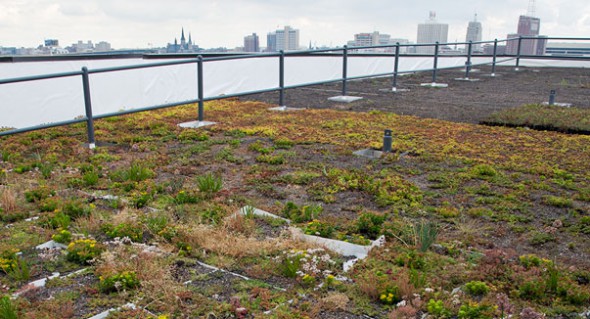Hanging Gardens Specializes in Green Roofs
Or blue roofs, its new innovation. The Milwaukee company seeks to become a leader in the field.
In ancient times, the Hanging Gardens of Babylon was one of the seven wonders of the world. It might have been the world’s first green roof. Nowadays, Hanging Gardens of Milwaukee is beginning to win a reputation for its expertise with green roofs. The company, founded in 2009, has by now completed over 90 projects. Most of them are in Milwaukee, but there are plenty of designs its helped create or products it has sold in cities like New Orleans, St. Louis, and Madison,.
Hanging Gardens was founded by Anthony Mayer and Daniel Philipp, with the goal of creating storm water management systems that can retain water safely and either reuse it to grow plant life on rooftops or dispose of it in a proper manner. Mayer, who has degrees in architecture and marketing, noticed that the prevailing method of handling storm water in the area was inefficient and saw a problem to be solved.
“We had seen a few of the storm water management systems in the area and noticed that there were some things wrong with it,” Mayer says, “and we set out to offer new solutions.”
The company offers some 400 products needed to create green roofs: pavers, roof membranes, drainage mats, plants and other products for architects, contractors and landscapers. “We have the largest product list for storm-water management products for green infrastructure in the world,” Mayer told the Milwaukee Journal Sentinel. The company also consults with those wanting to create green roofs.
The designers are often tasked to layout greenroof architecture; a style of landscaping that involves creating bioswales to run water off the roof while helping it absorb enough water to keep the vegetation growing. Tippecanoe Presbyterian Church on Milwaukee’s far South Side is a great example of the sustainable green roof systems that Hanging Gardens designs. The church grows many types of vegetables on the roof of the building and uses them in their soup kitchen to feed the hungry.
Mayer got his company’s name out to other cities by hooking up with other water management companies through the Milwaukee Metropolitan Sewerage District and grant programs. The company likes to maintain good relationships based on trust, according to Lauren Hildreth, the marketing and communications specialist for Hanging Gardens, and make sure it delivers for customers. “We stand behind what we have and we definitely try to select our products wisely,” she says.
At the New Orleans International High School, the company is helping to create a three-tiered system featuring a “blue roof,” which is designed to retain water rather than run it off. Few architecture firms use this method of storm water management, but Hildreth believes it has advantages that green roofs lack. “It will actually be able to hold water when it’s raining until after the storm is over and the sewer system water has gone down, and then you can drain the water. So there’s a lot of opportunity there.”
With all of the work that goes into selecting products from suppliers, providing those products to clients, designing the architecture for the roofs, and dealing with any other issues along the way, it may be hard to believe that Hanging Gardens is no large operation.
So how do they get it done with so few people? Mayer says the company is mostly doing projects it has done before. “Even though there’s a lot of complexity to what we do, they’re all mostly similar, with a few things that are changed as the job calls for,” he notes.
Hanging Gardens is passionate about collaborating with other companies to develop better ways to manage storm water systems. Company representatives recently attended WEFTEC, a water quality conference in which professionals from around the world get together and discuss and learn about the best and newest technologies in the field. The event, held in Chicago, featured Mayer on one of the panels to discuss new green infrastructure, along with professionals from Milwaukee Metropolitan Sewerage District and a company from New York called Vegetal i.D. Hildreth says Hanging Gardens and Vegetal i.D. have a great working relationship and understand the importance of collaboration.
“I think a lot of the people in this industry are driven by passion and care for protecting our water resources, reducing the impact on our environment, and saving money. It’s a huge piece of sustainability, and it can’t really be denied anymore,” she says.
Hanging Gardens has ambitious growth plans, but for Mayer it’s about the mission as much as the money.
“I enjoy doing what I do,” Mayer says. “I try to be ecologically smart and friendly and I teach my kids things on how to protect the environment. When I go to work every day, it’s not always easy, it’s very challenging. But every project we do makes the environment better, and that really makes me feel good about what I do.”
City Business
-
New Bookstore Tailored For Children of Color
 Apr 14th, 2022 by Michael Holloway
Apr 14th, 2022 by Michael Holloway
-
Vintage Clothing Shop For Brady Street
 Feb 26th, 2021 by Graham Kilmer
Feb 26th, 2021 by Graham Kilmer
-
All About Lion’s Tooth Bookstore
 Jan 19th, 2021 by Michael Holloway
Jan 19th, 2021 by Michael Holloway






















Green roofs and sidewall gardens also offer a cooling benefit to buildings. Traditional black roof tops reach temperatures of 160 degrees on warm summer days. A cool white roof reaches about 110 degrees. A green vegetation roof maintains ambient temperatures and offer further building cooling through the plant process called evapotranspiration. Moisture leaving the soil through the plant life is nature’s air cooling system. This effect can be felt in comparison of standing in the shade of a building overhang and under a tree. Large Oak trees transpire about 300 gallons of groundwater per day and provide this same cooling effect under their leafy canopy.
Installation of a green roof should include a plan for watering during droughty periods to maximize this cooling effect and the building manager needs training in the benefits and operation of a greener buildings’ full operation to maximize efficiencies.
Many commercial buildings use air conditioning about six months per year and use roof top units. An air handing unit located in the ambient temperatures of a green roof will operate much more efficiently than on a traditional black roof at 160 degrees. Roof membrane life is also extended due to lower heat, and protection for ultraviolet rays of the sun.
Great to see this kind of business in Milwaukee.